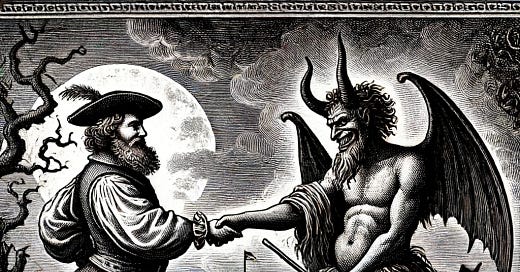Stephen Cochrane: Scotland’s Most Notorious Deal Maker
In the rich tapestry of Scottish history, the Cochrane family name weaves through centuries of Renfrewshire’s chronicles. Among the many stories that have passed down through generations, the legend of Stephen Cochrane and the Clippens estate stands out for its blend of mystery, myth, and historical intrigue.
The Historical Context
The Cochranes have long been associated with Renfrewshire, particularly in the parishes of Kilbarchan, Paisley, Lochwinnoch, and Neilston. Their history dates back to at least the 13th century, with notable figures like Waldevus de Cochran and William Cochrane marking their place in Scottish annals. However, one of the more enigmatic figures in the family’s lore is Stephen Cochrane of Linwood, a man whose story intertwines with the supernatural.
The Cochrane family, like many noble houses, had its roots deeply entrenched in the land they owned and the power they wielded. Their lineage was not only a matter of pride but also a testament to their influence and longevity in the region. The early records show that the Cochranes were involved in significant events and had substantial holdings that cemented their status in Scottish history.
The Legend
Stephen Cochrane’s tale is one steeped in the supernatural. Local tradition claims that Stephen sold his soul to the devil in exchange for a peck of gold. The deal was reportedly struck in a clandestine manner, with the devil himself agreeing to fill a dish with gold. In a cunning move, Stephen is said to have clipped a piece of the devil’s tail, thereby securing his peck of gold while simultaneously outwitting the Prince of Darkness.
This clever act supposedly gave the name "Clippens" to the Cochrane estate. Although such tales might seem far-fetched, they reflect the rich oral traditions and folklore that are an integral part of Scotland’s cultural heritage. The name Clippens, thus, carries with it a hint of both admiration for Stephen's cunning and a whisper of fear for the dark pact he allegedly made.
Folklore in Scotland often intertwines real historical events with fantastical elements, creating a tapestry of stories that are both entertaining and culturally significant. The legend of Stephen Cochrane and Clippens is a prime example of how myths can shape the identity of a place and its people.
Witchcraft Accusations
Adding a darker twist to Stephen Cochrane’s story, historical records reveal that he was apprehended for witchcraft in 1650. This accusation aligns with the superstitions and fear of the supernatural prevalent in 17th-century Scotland. The witchcraft trials of that era saw many individuals accused and often executed on dubious grounds, and Stephen Cochrane’s association with such charges only deepened the mysterious aura surrounding him.
The witchcraft trials of the 17th century were a dark chapter in Scottish history, marked by paranoia and the persecution of many innocent people. Stephen's accusation was a reflection of the times when fear and superstition often overshadowed reason and justice. It also highlights the precarious nature of life during that period, where a single accusation could lead to dire consequences.
The Clippens Estate
Despite the eerie legends, the Clippens estate itself became a significant part of the Cochrane legacy. By the late 18th century, John Cochrane, a descendant of Stephen, owned the estate. John was noted for rebuilding the mansion with a slate roof and office houses in the form of a court, as mentioned by William Semple in his continuation of the History of Renfrewshire in 1782. The estate had been in the family for over three hundred years, a testament to the Cochranes’ enduring presence in the region.
John Cochrane’s improvements to Clippens reflected a blend of tradition and modernity, indicating the family’s adaptability and resilience through changing times. His marriage to Mary Wilson of Lochwinnoch further solidified the Cochranes' status and influence in Renfrewshire. The rebuilding of the Clippens estate was not just a physical renovation but also a symbol of the family's enduring legacy and their commitment to preserving their heritage.
Peter Cochrane: From India to Clippens Estate
In the 18th century, Peter Cochrane, a direct descendant of Stephen, brought a new chapter to the family history. Peter accumulated considerable wealth through his service with the East India Company and eventually acquired the Clippens estate. His life, marked by legal disputes over inheritance and claims, continued to add layers of complexity to the Cochrane saga.
Peter’s marriage to a native Indian lady, Raheim Beebee, and the subsequent family disputes over his estate highlighted the global reach and intricate personal dynamics within the Cochrane lineage. The family’s legacy, intertwined with tales of wit, witchcraft, and worldly success, paints a vivid picture of their storied past. Peter's time in India and his marriage to Raheim Beebee also reflect the expanding horizons of the Cochrane family, connecting their story to broader global histories of trade and colonialism.
Peter Cochrane’s return to Scotland with his accumulated wealth and the controversies that followed underscore the challenges of maintaining family legacies in the face of changing social and economic landscapes. His story is a testament to the complexities of family dynamics and the ways in which personal decisions can have lasting impacts on family history.
The Enduring Legacy
The legend of Stephen Cochrane and the Clippens estate offers a fascinating glimpse into the blend of history and folklore that defines the Cochrane family narrative. It is a story that captures the imagination, reflecting the enduring allure of Scottish heritage. As we delve into these tales, we uncover not just the history of a family, but the cultural and societal threads that have shaped Scotland itself.
The Cochranes’ story is more than just a series of historical events; it is a reflection of the human experience, marked by ambition, ingenuity, and the complex interplay of myth and reality. The legend of Clippens, with its mix of the supernatural and the historical, serves as a reminder of how stories can preserve the essence of a family's legacy across generations.





